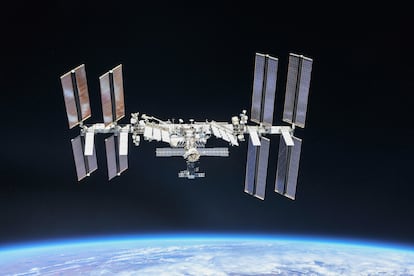How to crash a football-field-sized habitable spacecraft into Earth
NASA has taken up SpaceX’s proposal to crash the International Space Station into the Pacific Ocean. The firm plans to do this with a Dragon capsule spacecraft, starting in 2030

Everything that goes up must come down, and the International Space Station (ISS) is no exception. NASA has awarded SpaceX the project to build the vehicle that will be used to bring it down in a few years, perhaps as early as 2030.
Several factors were involved in this decision. The first and most important is that the station has become old. Its first module — of Russian design, but paid for by NASA — was launched 26 years ago. It may not seem like that long, but the rigor of the space environment takes its toll on materials. Much of the equipment has aged: the astronauts now spend a good part of their time in orbit on maintenance and repairs.
Another factor is Russia’s decision to abandon its participation in the project by 2028. This is partly because of the tension unleashed with its Western colleagues following the war in Ukraine and the subsequent sanctions imposed on Russia. However, Russia also has plans to build its own space station, probably in collaboration with China.
The ISS is gradually losing altitude due to the friction of the air streams, which are still present even at 248 miles from the Earth’s surface, the height at which the station orbits. From time to time, it has to fire up its engines to rise again. But these engines are installed in the Russian segment of the station. Hence, when Russia finally abandons the station, this maneuvering capacity will disappear.
Studies have been made to find alternatives, such as launching vehicles — equipped with propulsion systems — to join the station and return it to its normal flight altitude. But these are expensive projects that require a lot of development time. Russia had also offered its Progress automatic spaceships — the same ones it occasionally uses to make the station ascend — although a concrete plan has never been established to bring the ISS down.
Years ago, Moscow promised its support — if necessary — to deorbit the space station, using the same Progress cargo ships. But given the current geopolitical situation, NASA has opted to develop its own alternative, in case relations with Russia worsen. Thus, in September 2023, an open bid for projects was held, which was attended by several companies in the aerospace sector. The winner was SpaceX, Elon Musk’s company, which — once again — presented the most economical proposal, priced at around $850 million. With its Starship lunar lander, SpaceX has also won the bid to transport the next set of astronauts who will set foot on the moon.

The station weighs about 420 tons and is the size of a football field. It’s by far the largest artificial object above our heads in Earth’s orbit. To get rid of such a mass, the only solution is to attach a sufficiently powerful engine to it, to slow it down and force it to fall into the ocean. And in a controlled manner, if possible.
The station was built piece-by-piece. More than 40 launches were required. Each module — which usually didn’t exceed 20 tons — was sent into space by a Russian rocket, or in the American cargo hold of the shuttle. But now, the matter at hand involves deorbiting the entire unit at once. And this will require a very powerful engine.
SpaceX’s proposal is, in effect, another monstrous task. It requires an unmanned Dragon capsule spacecraft, whose luggage racks have been expanded to house fuel tanks and 30 engines, each with a thrust of 88 pounds. It will weigh about 30 tons in total, roughly the same as a full Apollo lunar ship.
So, when exactly will the ISS be destroyed? NASA plans to carry out the procedure between 2030 and 2031. The last manned expedition will end in 2029. The deorbiter vehicle — which will be built by SpaceX, but will be owned by NASA and controlled from Houston — will remain attached to the station for a whole year, adjusting its orbit under remote control. When the day comes to deorbit the station, the 30 engines will reduce the speed of the station by about 93 miles per hour, which is now moving at an orbital speed of 17,150 miles per hour. This braking will be done gently, so as not to stress a structure that could easily break. The maneuver will last about an hour, during which the ISS will gradually lose altitude until it hits the densest layers of the atmosphere, about 30 miles above the ocean.
An unpredictable process
From that point onwards, it’s difficult to predict how the disintegration process will take place. It’s certain that the first objects to fall off will be the eight large solar panels. Then, the cross-beam supporting the radiators and some experiments — such as the massive alpha spectrometer, a seven-ton cylinder — will probably give way. And, after that, the connections between the different modules will break apart and burn separately, as tiny fragments.
There aren’t many precedents to serve as a guide for this operation. In 1973, Skylab — the first U.S. space station — disintegrated somewhat later than planned. Some fragments fell into the outback of the Australian interior. NASA was fined $400 for littering on public land. Then, 28 years later, the Mir station — operated by the Soviet Union and, subsequently, the Russian Federation — fell into the Pacific in a spectacular display of fireworks, but without causing damage to people.
The ISS will also head towards the South Pacific, specifically towards what is known as Point Nemo, the most remote place on the planet, halfway between New Zealand and the southern tip of Patagonia. This will put it more than 1,200 miles from land (which generally consists of uninhabited islets). Since 1971, this part of the ocean has been used as a space graveyard, where useless satellites are brought down. At the bottom of the water — at a depth of about 12,000 feet — lie the battered remains of more than 300 vehicles that survived the plunge into the atmosphere. This makes the area very poor in nutrients and, consequently, in marine life.
Sign up for our weekly newsletter to get more English-language news coverage from EL PAÍS USA Edition
Tu suscripción se está usando en otro dispositivo
¿Quieres añadir otro usuario a tu suscripción?
Si continúas leyendo en este dispositivo, no se podrá leer en el otro.
FlechaTu suscripción se está usando en otro dispositivo y solo puedes acceder a EL PAÍS desde un dispositivo a la vez.
Si quieres compartir tu cuenta, cambia tu suscripción a la modalidad Premium, así podrás añadir otro usuario. Cada uno accederá con su propia cuenta de email, lo que os permitirá personalizar vuestra experiencia en EL PAÍS.
¿Tienes una suscripción de empresa? Accede aquí para contratar más cuentas.
En el caso de no saber quién está usando tu cuenta, te recomendamos cambiar tu contraseña aquí.
Si decides continuar compartiendo tu cuenta, este mensaje se mostrará en tu dispositivo y en el de la otra persona que está usando tu cuenta de forma indefinida, afectando a tu experiencia de lectura. Puedes consultar aquí los términos y condiciones de la suscripción digital.
More information
Archived In
Últimas noticias
From Christmas movies to carols: Trump administration uses the holidays to push its anti-immigrant agenda
Trump’s worldview clashes with a Europe trying to defend itself
The program that guarantees Denver migrants will end up on the ‘Success Wall’
Venezuelan oil, the ultimate prize coveted by the United States
Most viewed
- Christian Louboutin: ‘Young people don’t want to be like their parents. And if their parents wear sneakers, they’re going to look for something else’
- ‘El Limones’ and the growing union disguise of Mexican organized crime
- The low-cost creative revolution: How technology is making art accessible to everyone
- ‘We are dying’: Cuba sinks into a health crisis amid medicine shortages and misdiagnosis
- Cartels in Mexico take a leap forward with narco-drones: ‘It is criminal groups that are leading the innovation race’











































